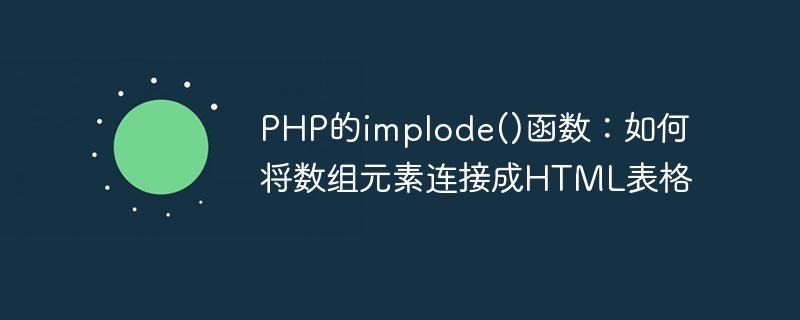Home >Backend Development >PHP Tutorial >PHP's implode() function: How to connect array elements into an HTML table
PHP's implode() function: How to connect array elements into an HTML table
- 王林Original
- 2023-11-04 10:54:42817browse

PHP's implode() function: How to connect array elements into an HTML table, specific code examples are needed
PHP is a scripting language widely used in web development , it has powerful ability to process data. When developing web applications using PHP, we often need to connect elements in arrays and render them into HTML tables. At this time, PHP provides a very useful function implode(). This article will introduce how to use this function to connect array elements into an HTML table, and attach specific code examples.
First, let us understand the basic usage of the implode() function. The implode() function connects the elements in the array into a string. Its syntax is as follows:
string implode (string $glue, array $pieces)
The $glue parameter represents the connection A string of array elements, and the $pieces parameter represents the array to be concatenated.
Next, we will use the implode() function to build a simple HTML table. Suppose we have an associative array containing the names, ages, and genders of students. We want to display this information in an HTML table.
The following is a code example:
<?php
$students = array(
array("name" => "张三", "age" => 20, "gender" => "男"),
array("name" => "李四", "age" => 21, "gender" => "女"),
array("name" => "王五", "age" => 19, "gender" => "男")
);
$table = "<table>
<thead>
<tr>
<th>姓名</th>
<th>年龄</th>
<th>性别</th>
</tr>
</thead>
<tbody>";
foreach ($students as $student) {
$row = "<tr>
<td>".$student['name']."</td>
<td>".$student['age']."</td>
<td>".$student['gender']."</td>
</tr>";
$table .= $row;
}
$table .= "</tbody></table>";
echo $table;
?>The above code first defines a $students array, which contains information about three students. Then, we created a $table variable and initialized it to the basic structure of an HTML table. Next, we use a foreach loop to traverse the $students array and add each student's information as a row to the $table variable. Finally, we print out the $table variable to get a complete HTML table.
Run the above code, the output result is:
<table>
<thead>
<tr>
<th>姓名</th>
<th>年龄</th>
<th>性别</th>
</tr>
</thead>
<tbody>
<tr>
<td>张三</td>
<td>20</td>
<td>男</td>
</tr>
<tr>
<td>李四</td>
<td>21</td>
<td>女</td>
</tr>
<tr>
<td>王五</td>
<td>19</td>
<td>男</td>
</tr>
</tbody>
</table>Through the above code example, we can see that with the help of the implode() function, connecting array elements into an HTML table becomes very simple. Just iterate through the array and build the corresponding HTML tags and concatenate these tags through the implode() function.
To summarize, PHP's implode() function provides a simple and powerful method to concatenate array elements into strings. In web development, we can use its features to connect array elements into HTML tables and display them to users. The above is an introduction to how to use the implode() function to connect array elements into an HTML table, as well as the corresponding specific code examples. Hope this article helps you!
The above is the detailed content of PHP's implode() function: How to connect array elements into an HTML table. For more information, please follow other related articles on the PHP Chinese website!

